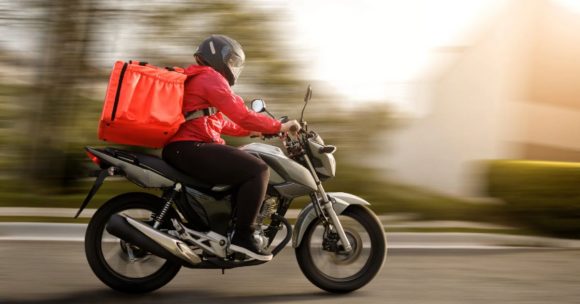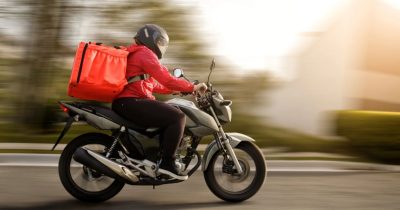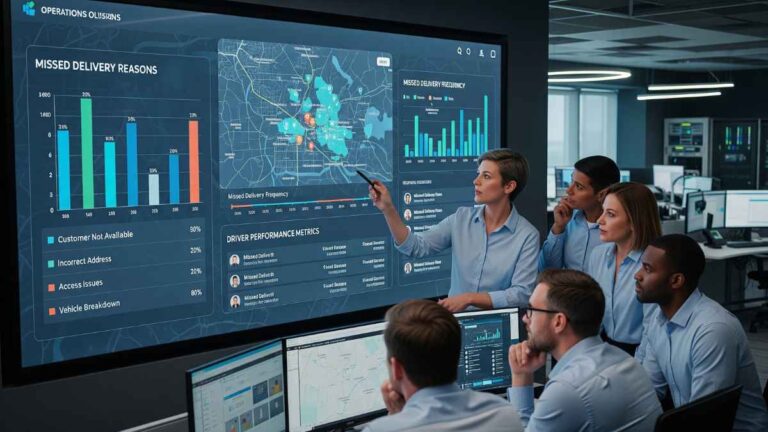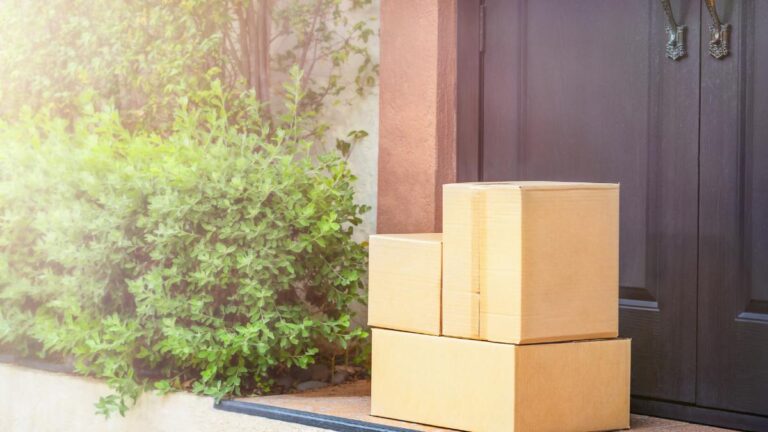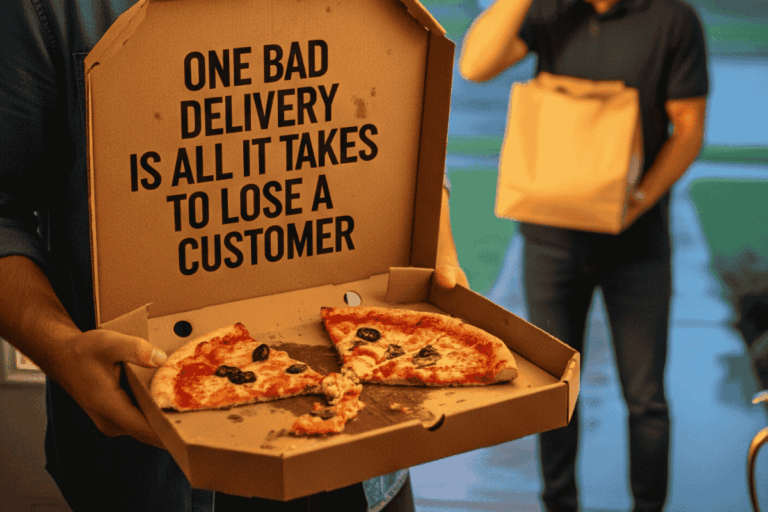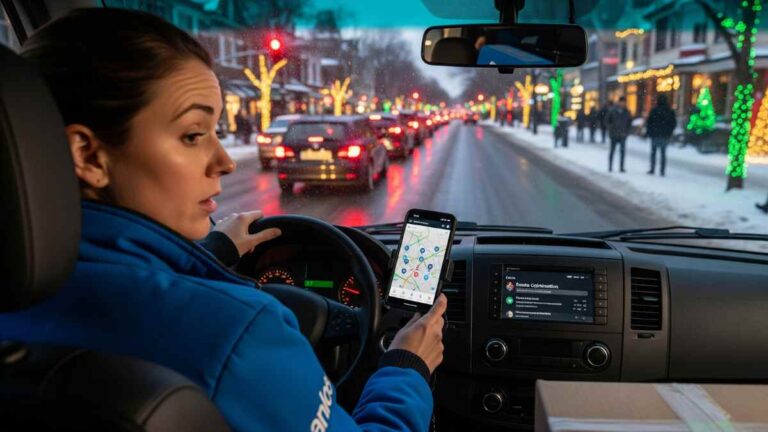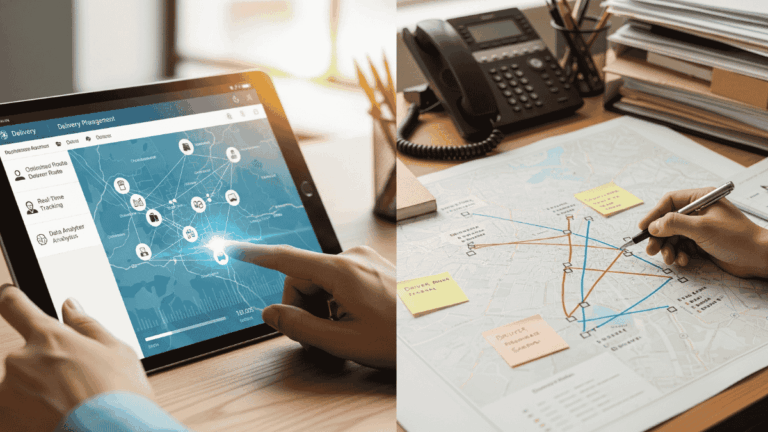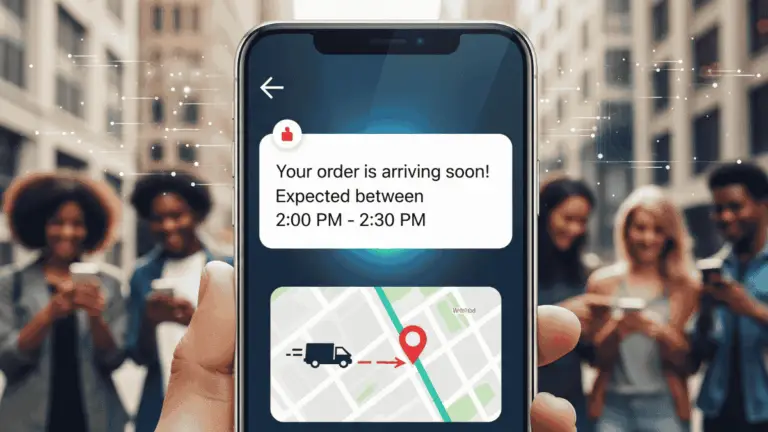Take a moment to look around at the logistics industry. Whether you’re a delivery company shuttling parcels across the city, a restaurant bringing a customer’s favorite meal straight to their door, or a postal worker on the last stretch of your route—last-mile delivery is the final step.
And it’s crucial. The ‘last mile delivery problem’ represents significant challenges in the logistics sector, focusing on inefficiencies and their impact on costs and customer satisfaction.
You have to get it right.
In this article, we’ll break down everything you need to know about last-mile delivery—what it is, why it matters, and how it’s reshaping the logistics world.
Plus, we’ll discuss the latest innovations and introduce three challenges that will help you master this all-important final mile.
Definition and explanation of last mile delivery
Last mile delivery refers to the final stage of the delivery process, where a package is transported from a local warehouse or fulfillment center to its final destination, typically a private residence or retail store.
This stage is crucial in the delivery process, as it directly impacts the customer’s experience and satisfaction.
Last mile delivery involves a range of activities, including route planning, dispatching, real-time tracking, proof of delivery, and reporting. Getting this stage right ensures that customers receive their packages on time and in good condition, which is essential for maintaining customer loyalty and trust.
Brief overview of the last mile delivery process
The last mile delivery process typically involves the following steps:
- Pickup from a local warehouse or fulfillment center: The journey begins when a delivery driver collects the package from a nearby warehouse or fulfillment center.
- Transportation to the customer’s location: The package is then transported through various delivery routes, which can be optimized using advanced software to avoid traffic and reduce travel time.
- Delivery to the customer’s doorstep: Finally, the package reaches its final destination, where proof of delivery is often required to confirm successful delivery.
This process can be complex, especially in urban areas with heavy traffic and narrow roads, or in rural areas with long distances between stops.
Efficient last mile logistics are essential to overcome these challenges and ensure timely deliveries.
How is technology changing last-mile delivery?
The logistics industry is embracing technological advancements to further refine the last-mile delivery process.
Delivery management software solutions are at the forefront of this transformation, empowering businesses with tools like route optimization, real-time tracking, and proof of delivery.
Let’s take a closer look at how these innovations are changing the game of logistics:

Route optimization
By analyzing real-time data on traffic conditions, weather, and vehicle load, route optimization software identifies the most efficient delivery routes. This reduces travel time and fuel consumption, enabling businesses to fulfill more orders with the same resources.
Real-time tracking
Customers now expect to know exactly where their packages are at any given moment. Real-time tracking not only meets this expectation but also allows logistics managers to monitor fleet performance and address any disruptions proactively.
Proof of Delivery (POD)
With this technology, businesses can digitally capture signatures, photos, or GPS coordinates as evidence of successful deliveries. This eliminates the paperwork and minimizes disputes, improving overall customer satisfaction.
Locate2u has delivery management software that can help logistics companies make their delivery process simple.
Last mile delivery innovation
Let’s now take a look at some last mile delivery innovations.
Micro-hubs
Micro-hubs are small, strategically located urban warehouses that bridge the gap between traditional distribution centers and end customers. Positioned typically within a 1 to 5-kilometer radius of delivery destinations.
These hubs enable logistics providers to stage goods closer to the final delivery points, facilitating faster, more cost-effective, and eco-friendly deliveries.
Amazon first launched its micro-mobility hub in London and Manchester in 2022. Customers in locations such as Belfast, Northern Ireland also started benefitting from these micro-mobility hubs.
But micro-hubs take things one step further – thinking about the environment. Micro-hubs provide an answer to taking the environment into consideration by shortening delivery routes and allowing smaller, electric vehicles or bikes to make last-mile deliveries, reducing the carbon footprint.
Real-World Example of a Micro-Hub
A micro-hub is a small, strategically located warehouse or fulfillment center that serves as a hub for last mile deliveries.
For example, Amazon has established micro-hubs in various cities to enable faster and more efficient last mile deliveries.
These micro-hubs are typically located near high-demand areas and are equipped with advanced technology to streamline the delivery process.
By positioning goods closer to the final destination, micro-hubs help reduce delivery times and improve overall efficiency.
This approach not only speeds up the delivery process but also reduces the carbon footprint by allowing smaller, eco-friendly vehicles to be used for the final leg of the journey.
Real-word example of a micro-hub
Picture this: You’re a business owner managing a restaurant in a bustling city center. Your customers want their meals delivered hot and fast, but traffic congestion often causes delays.
Enter the micro-hub—a small warehouse set up just a few blocks from your restaurant. Instead of relying on large delivery trucks, you partner with a local logistics provider that uses an e-cargo bike stationed at the micro-hub.
With orders consolidated at the hub, the bike can zip through traffic and deliver meals to customers in minutes, ensuring a seamless dining experience.
Micro-hubs don’t just reduce delivery times—they provide critical data that helps logistics companies better understand urban delivery patterns.
This insight allows them to adjust fleet sizes, optimize routes, and ultimately provide better service to businesses like yours
Zero emission trains
In early 2024, Varamis Rail launched a zero-emission freight service in London. This service allows goods to be delivered by electric trains in the city.
Varamis Rail’s fast logistics service to central London provides faster and more efficient deliveries than existing options. It will also be at a lower cost than current methods. The freight service will directly reduce the carbon footprint of UK businesses.
The topic of sustainability is gaining momentum. Companies in the UK and worldwide are taking note of doing business sustainably.
Varamis Rail, the UK’s pioneer in high-speed, zero-emission rail logistics, has been revolutionizing the sector. Awarded a ‘first-of-a-kind’ grant by Innovate UK in September 2022, with support from the department for transport, the company has been enhancing its rail operations.
Crowdsourced delivery networks: Tapping into everyday people
Imagine a neighborhood where your package is delivered by a neighbor on their way home from work. That’s the magic of crowdsourced delivery networks.
Crowdsourced delivery is a model in which delivery tasks are outsourced to a network of individuals, often part-time or freelance drivers, rather than a traditional company-owned fleet.
It leverages people who are already on the move, using their own vehicles or modes of transportation to make deliveries.
This approach is similar to how ride-sharing apps like Uber and Lyft operate, but for goods instead of passengers.
In contrast, companies like Amazon use in-house delivery services to manage their own fleet of vehicles and drivers, providing better control over delivery operations and improving efficiency.
In crowdsourced delivery, businesses tap into this flexible workforce to make deliveries more efficiently, especially in peak times or specific regions where their in-house logistics might fall short.
Benefits of crowdsourced delivery
- Flexibility: Businesses can scale delivery capacity up or down based on demand.
- Cost-effectiveness: Since there’s no need for a full-time fleet, companies save on overhead.
- Faster deliveries: Drivers are often locals who can make quicker deliveries within smaller areas.
How are robots used for last-mile delivery?
Picture this: It’s a Friday night and you’ve just arrived home from work, too tired to drive down to your favorite restaurant to buy food. Thanks to robotic food delivery, getting into your car doesn’t have to be an option anymore. You can now order groceries and have them delivered to your doorstep.
Retail chains are hopping onto the fast delivery trend and delivering items to customers quickly. Talk about the ultimate convenience. Walmart has brought the ease of shopping to thousands of homes in Dallas Fort-Worth with drone delivery available to 75% of the community.

Why are restaurants using robotic food delivery?
Robots can significantly reduce the cost of delivery. Robots do not require wages, tips, or breaks, unlike human delivery drivers. This reduction in labor costs is particularly attractive in an industry known for its thin profit margins.
Robotic deliveries can offer a more predictable and transparent delivery experience with real-time tracking, autonomous navigation, and automated operation.
Customers can track their orders in real-time and receive notifications upon arrival. This level of service enhances customer satisfaction and loyalty.
Additionally, business management platforms are crucial in enabling smart catering by providing cloud-intelligent service support for robotic food delivery systems.
But robotic food delivery is not just taking place with restaurants. Earlier this year, the University of South Carolina in partnership with Grubhub and Starship Technologies, introduced autonomous food delivery.

Last mile delivery market: Growth drivers
Grand View Research reports the last mile delivery market is set to experience good growth in the next six years.
The report adds the key market drivers include:
- Rising consumer expectations for same-day or next-day deliveries.
- The imperative for real-time tracking and visibility.
- The rise of on-demand services.
- Challenges posed by urban congestion and sustainability considerations.
How important is speed in delivery?
Absolutely. Speed does matter.
Australian expert and founder of Zoom2u Technologies (ASX:Z2U) Steve Orenstein gives a ‘golden nugget’ when it comes to speed. “Same-day delivery is the gold standard for speed, ” says Orenstein.
Rapid order fulfillment and its impact on last mile delivery
Rapid order fulfillment is becoming increasingly important in today’s fast-paced market. With the rise of same-day delivery and two-day shipping, customers expect their orders to be fulfilled quickly and efficiently.
This puts pressure on last mile delivery services to deliver packages quickly and accurately. To meet this demand, last mile delivery services are investing in advanced technology, such as route optimization software and real-time tracking, to streamline the delivery process and improve customer satisfaction.
These technologies help delivery drivers navigate the most efficient routes, avoid delays, and provide customers with real-time updates on their delivery status. As a result, businesses can meet the high expectations of modern consumers and maintain a competitive edge in the market.

Challenges in last-mile delivery and how to overcome them
You’re on a last-mile delivery run, but challenges have popped up along the way. It’s no secret—the logistics industry can throw plenty of obstacles your way.
But don’t worry! Here’s how you can tackle those hurdles and conquer the final mile with confidence. The last mile delivery problem often leads to inefficiencies, making this stage the most costly and challenging, which can significantly impact business performance and customer satisfaction.
Delays
Imagine you’re a delivery company that delivers packages. Delays in your logistics can possibly cause you to lose customers.
You can beat the delay headache by using route optimization software. This technology can assist your drivers to avoid complicated, high traffic routes that are making you miss delivery deadlines.
Locate2u has route optimization software, so your drivers can make deliveries easily. Not only will you make timely deliveries, but your company will also keep drivers happy by giving them the right tools to complete their dispatches.
How to overcome delays
Investing in route optimization software will help your drivers deliver better.
This technology helps reduce travel time. The software also takes weather hazards into account. You can give customers peace of mind with on-time deliveries.
Optimizing warehousing
Another way to overcome delays in last-mile delivery is to optimize warehousing and fulfillment centers.
Optimizing the use of delivery vehicles and strategically placing transportation hubs can significantly reduce travel time and improve delivery efficiency.
Your logistics company can establish smaller warehouses close to high-demand areas. This will reduce travel time in making deliveries, and will assist to increase delivery turnaround.
Amazon has brought micro-mobility hubs to Ireland. Micro-mobility hubs support deliveries by electric cargo (e-cargo) bikes and on foot, reducing the need for delivery vans in city centers.
These e-cargo bikes can also maneuver faster through traffic, where a traditional vehicle will come to a complete stop in peak traffic.
Limited access to remote areas
Your delivery business has been operating increasingly in remote locations. The remote locations are turning up the orders.
However, your bulky delivery vans are not cutting through the rough terrain. Your vans are also being scratched and damaged en route to a customer.
How to overcome limited access to remote locations
Drones have made it possible to deliver items to remote areas. There are several reasons drones are being used for delivery.
The standout has to be the speed of delivery. Drones fly above ground and are not restricted by traffic, making it easier to reach the final destination.
Companies like Walmart and Amazon are utilizing drones to deliver items to a customer’s doorstep. The direct drone journey to a location can save a delivery driver time. A traditional van may take several hours to reach a remote location, or be unable to make a delivery.
DJI, a Nepalese drone service Airlift, video production company 8KRAW, and mountain guide Mingma Gyalje Sherpa have completed the first successful drone delivery tests on Mount Everest.
This proves that drones can beat the remote location dilemma. This innovation is particularly useful for last mile deliveries in remote and hard-to-reach areas, ensuring that packages reach their final destination efficiently.
Logistics companies can’t begin to fathom how frustrating it is when a customer experiences a failed delivery. You may order a phone case but can’t receive the package because you work during delivery hours. There is a solution – parcel lockers.
5 Questions to ask for a failing last-mile delivery process
So, you’ve identified some of the common challenges in last-mile delivery. Now, to set yourself up for success, it’s time to explore even deeper.
Asking the right questions can help you uncover the root causes of inefficiencies and put you on the path to smoother operations.
Let’s explore five essential questions that can guide you toward overcoming these hurdles and optimizing your last-mile process.
Are my delivery routes optimized for speed and efficiency?
Am I using route optimization tools, and are they factoring in real-time traffic, weather conditions, and delivery windows?
Is my delivery fleet properly sized and equipped for current demand?
Do I have enough vehicles and drivers to handle peak delivery times, or are bottlenecks occurring because of resource shortages?
Are my customers receiving accurate, real-time tracking information?
Do my customers know exactly when to expect their delivery, and is the communication clear and timely, or are delays causing frustration.
Am I using the right technology to streamline the delivery process?
Are there gaps in my tech stack, such as outdated software or a lack of automation, that are slowing down operations and causing inefficiencies.
Are there recurring issues with delivery failures or returned goods?
Are delivery attempts frequently failing due to incorrect addresses, missed deliveries, or poor communication with customers, and how am I addressing these issues?
NOW READ: UK regulator unveils drone trials for everyday applications
About the author
Sharl is a qualified journalist. He has over 10 years’ experience in the media industry, including positions as an editor of a magazine and Business Editor of a daily newspaper. Sharl also has experience in logistics specifically operations, where he worked with global food aid organisations distributing food into Africa. Sharl enjoys writing business stories and human interest pieces.

